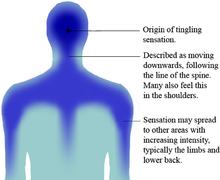
An autonomous sensory meridian response (ASMR)[2][3][4] is a tingling sensation that usually begins on the scalp and moves down the back of the neck and upper spine. A pleasant form of paresthesia,[5] it has been compared with auditory-tactile synesthesia[6][7] and may overlap with frisson.[8] ASMR is a subjective experience of "low-grade euphoria" characterized by "a combination of positive feelings and a distinct static-like tingling sensation on the skin". It is most commonly triggered by specific auditory stimuli, and less commonly by intentional attention control.[1][9]
The term ASMR can also refer to media (usually audiovisual) meant to evoke this phenomenon, with the sensation itself being informally referred to as "tingles".
- ^ a b Barratt, Emma L. & Davis, Nick J. (2015). "Autonomous Sensory Meridian Response (ASMR): a flow-like mental state". PeerJ. 3: e851. doi:10.7717/peerj.851. ISSN 2167-8359. PMC 4380153. PMID 25834771.
- ^ Marsden, Rhodri (20 July 2012), "'Maria spends 20 minutes folding towels': Why millions are mesmerised by ASMR videos" Archived 27 May 2020 at the Wayback Machine, The Independent.
- ^ McKinney, Kelsey (13 April 2017), "These Mesmerizing, Satisfying Slime Videos Are the Internet's New Obsession" Archived 19 May 2020 at the Wayback Machine, Intelligencer.
- ^ Rajan, Amol (23 April 2019), "ASMR is now mainstream" Archived 13 May 2020 at the Wayback Machine, BBC.
- ^ Cite error: The named reference
paresthesiawas invoked but never defined (see the help page). - ^ Simner, Julia; et al. (2006). "Synaesthesia: the prevalence of atypical cross-modal experiences" (PDF). Perception. 35 (8): 1024–1033. doi:10.1068/p5469. PMID 17076063. S2CID 2508540. Archived (PDF) from the original on 12 April 2022. Retrieved 2 July 2023.
- ^ Banissy, Michael J.; et al. (15 December 2014). "Synesthesia: an introduction". Frontiers in Psychology. 5 (1414): 1414. doi:10.3389/fpsyg.2014.01414. PMC 4265978. PMID 25566110.
- ^ Kovacevich, Alexsandra; Huron, David (17 January 2019). "Two Studies of Autonomous Sensory Meridian Response (ASMR): The Relationship between ASMR and Music-Induced Frisson". Empirical Musicology Review. 13 (1–2): 39–63. doi:10.18061/emr.v13i1-2.6012. ISSN 1559-5749. Archived from the original on 22 March 2023. Retrieved 2 July 2023.
- ^ Ahuja, Nitin K. (2013). "'It feels good to be measured': clinical role-play, Walker Percy, and the tingles". Perspectives in Biology and Medicine. 56 (3): 442–451. doi:10.1353/pbm.2013.0022. PMID 24375123. S2CID 43492129.